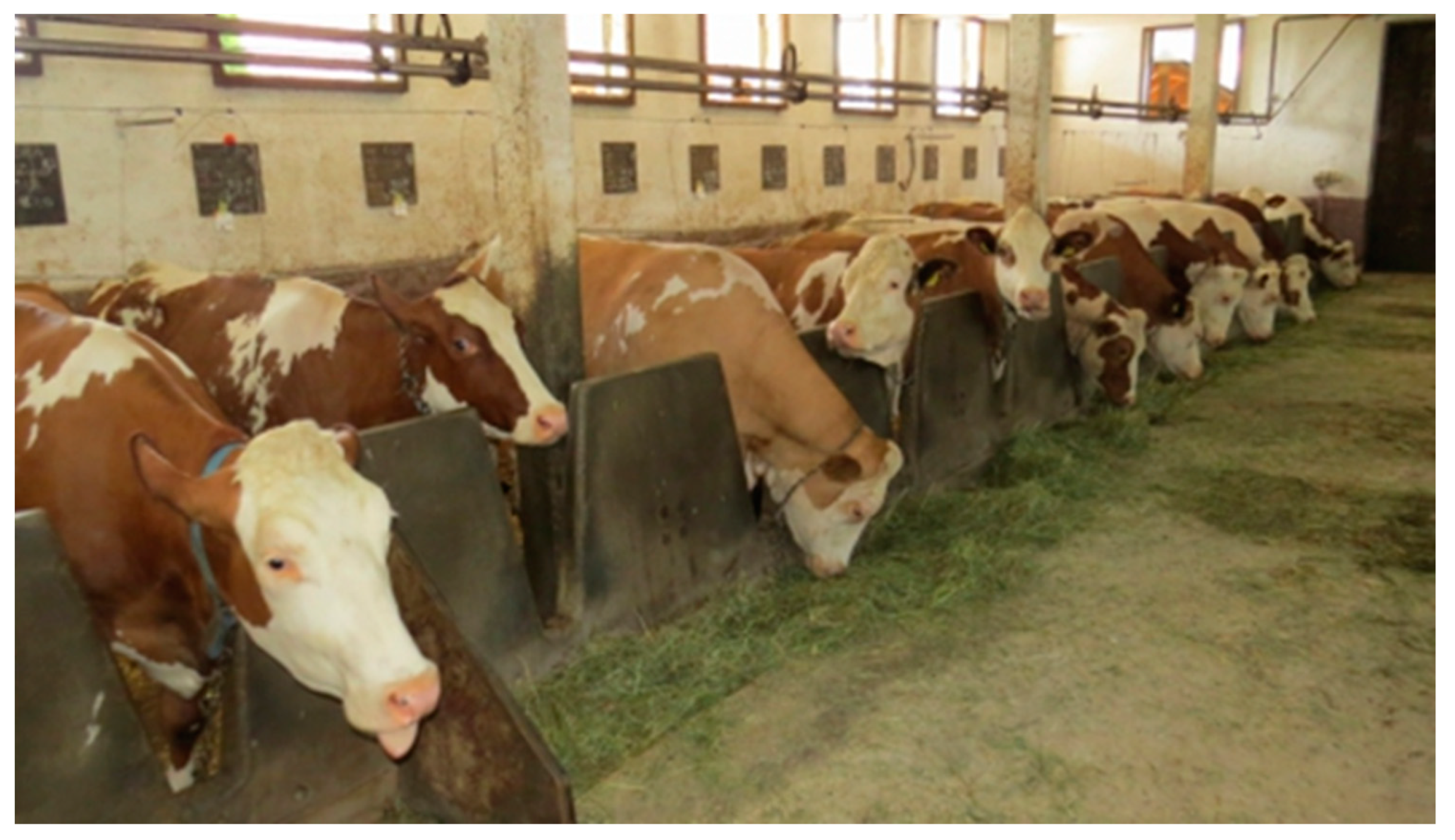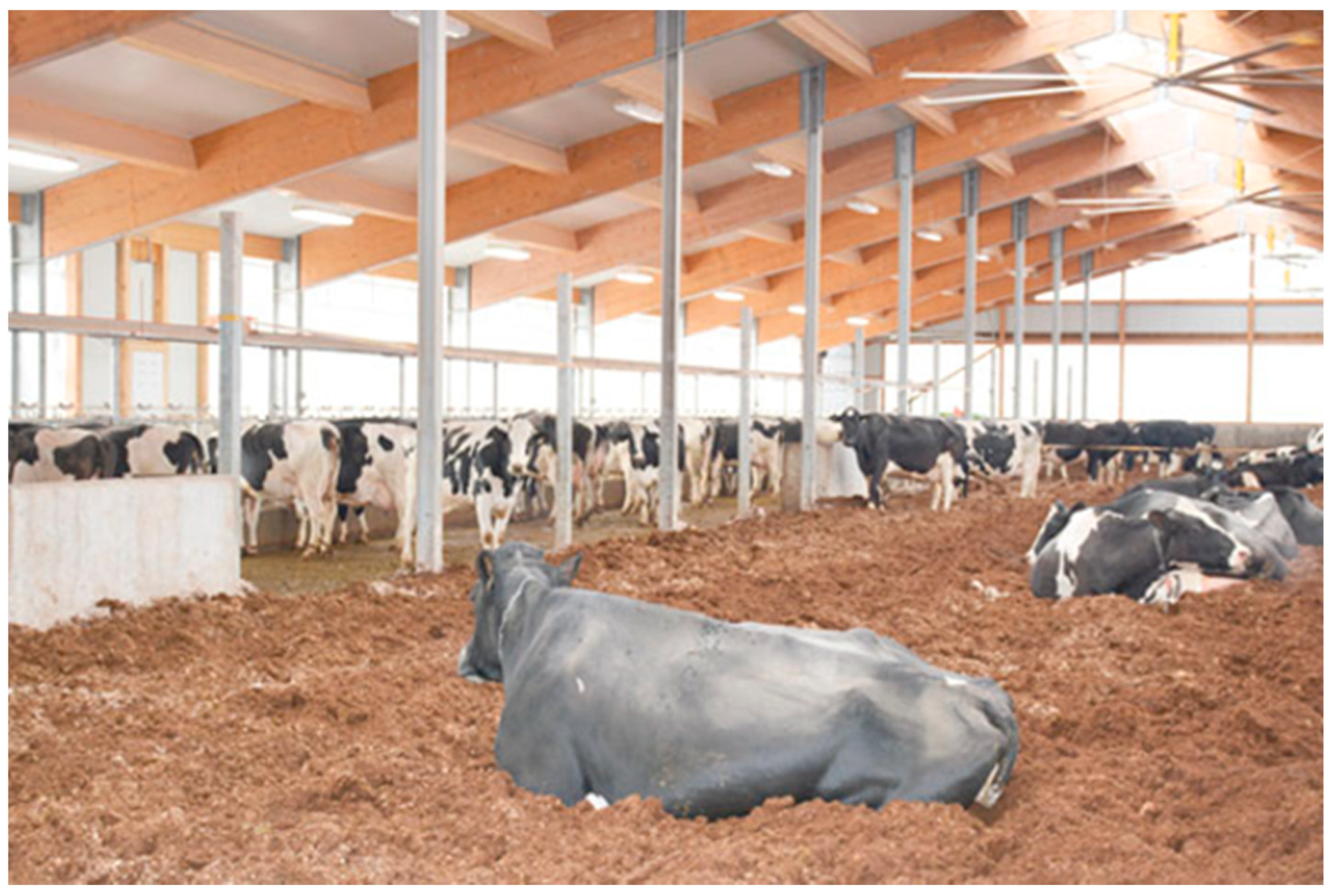Views of Consumers, Farmers and Stakeholders on Alternative Dairy Cattle Housing Systems
Abstract
:Simple Summary
Abstract
1. Introduction
2. Materials and Methods
2.1. Participants
2.2. Survey Design
2.3. Data Analysis
3. Results
4. Discussion
5. Conclusions
Author Contributions
Funding
Institutional Review Board Statement
Informed Consent Statement
Data Availability Statement
Acknowledgments
Conflicts of Interest
References
- Blanco-Penedo, I.; Ouweltjes, W.; Ofner-Schröck, E.; Brügemmann, K.; Emanuelson, U. Symposium review: Animal welfare in free-walk systems in Europe. J. Dairy Sci. 2020, 103, 5773–5782. [Google Scholar] [CrossRef]
- Galama, P.J.; Ouweltjes, W.; Endres, M.I.; Sprecher, J.R.; Leso, L.; Kuipers, A.; Klopčič, M. Symposium review: Future of housing for dairy cattle. J. Dairy Sci. 2020, 103, 5759–5772. [Google Scholar] [CrossRef]
- Leso, L.; Barbari, M.; Lopes, M.A.; Damasceno, F.A.; Galama, P.; Taraba, J.L.; Kuipers, A. Invited review: Compost-bedded pack barns for dairy cows. J. Dairy Sci. 2020, 103, 1072–1099. [Google Scholar] [CrossRef]
- Ferreira Ponciano Ferraz, P.; Araújo e Silva Ferraz, G.; Leso, L.; Klopčič, M.; Rossi, G.; Barbari, M. Evaluation of the Physical Properties of Bedding Materials for Dairy Cattle Using Fuzzy Clustering Analysis. Animals 2020, 10, 351. [Google Scholar] [CrossRef] [Green Version]
- Megan, E.; Waldrop, J.R. Consumer acceptance and willingness to pay for cow housing systems in eight European countries. Q Open 2021, 1, qoab001. [Google Scholar] [CrossRef]
- Klopčič, M.; Erjavec, K.; Waldrop, M.; Roosen, J.; Engel, P.; Galama, P.; Kuipers, A. Consumers’ and Farmers’ Perceptions in Europe Regarding the Use of Composted Bedding Material from Cattle. Sustainability 2021, 13, 5128. [Google Scholar] [CrossRef]
- Bewley, J.M.; Robertson, L.M.; Eckelkamp, E.A. A 100-year Review: Lactating Dairy Cattle Housing Management. J. Dairy Sci. 2017, 100, 10418–10431. [Google Scholar] [CrossRef]
- Breckler, S.J. Empirical validation of affect, behavior, and cognition as distinct components of attitude. J. Personal. Soc. Psychol. 1984, 47, 1191. [Google Scholar] [CrossRef]
- Weinrich, R.; Kühl, S.; Zühlsdorf, A.; Spiller, A. Consumer attitudes in Germany towards different dairy housing systems and their implications for the marketing of pasture raised milk. Int. Food Agribus. Man. 2014, 17, 205–222. [Google Scholar]
- Kühl, S.; Gauly, S.; Spiller, A. Analysing public acceptance of four common husbandry systems for dairy cattle using a picture-based approach. Livest. Sci. 2019, 220, 196–204. [Google Scholar] [CrossRef]
- Boogaard, B.K.; Oosting, S.J.; Bock, B.B. Defining sustainability as a socio-cultural concept: Citizen panels visiting dairy farms in the Netherlands. Livest. Sci. 2008, 117, 24–33. [Google Scholar] [CrossRef]
- Ellis, K.A.; Billington, K.; McNeil, B.; McKeegan, D. Public opinion on UK milk marketing and dairy cow welfare. Anim. Welf. 2009, 18, 267–282. [Google Scholar]
- Cardoso, C.S.; Hötzel, M.J.; Weary, D.M.; Robbins, J.A.; von Keyserling, M.A.G. Imagining the ideal dairy farm. J. Dairy Sci. 2016, 99, 1663–1671. [Google Scholar] [CrossRef] [Green Version]
- Clark, B.; Stewart, G.B.; Panzone, L.A. A Systematic Review of Public Attitudes, Perceptions and Behaviours Towards Production Diseases Associated with Farm Animal Welfare. J. Agric. Environ. Ethics 2016, 29, 455–478. [Google Scholar] [CrossRef] [Green Version]
- Wilson, P.; Lewis, M.; Ackroyd, J. Farm Business Innovation, Cooperation and Performance; Rural Business Research: Defra, UK, 2014; p. 69. [Google Scholar]
- van der Ploeg, D.J. Farmers’ upheaval, climate crisis and populism. J. Peasant Stud. 2020, 47, 589–605. [Google Scholar] [CrossRef]
- Scoones, I.M.; Edelman, S.; Borras, M.; Hall, R.; Wolford, W.; White, B. Emancipatory Rural Politics: Confronting Authoritarian Populism. J. Peasant Stud. 2018, 45, 1–20. [Google Scholar] [CrossRef] [Green Version]
- van der Ploeg, J.D.; Barjolle, D.; Bruil, J.; Brunori, G.; Costa Madureira, L.M.; Dessein, J.; Drąg, Z.; Fink-Kessler, A.; Gasselin, P.; de Molina, M.G.; et al. The economic potential of agroecology: Empirical evidence from Europe. J. Rural Stud. 2019, 71, 46–61. [Google Scholar] [CrossRef] [Green Version]
- Beaver, A.; Ritter, C.; von Keyserlingk, M.A.G. The Dairy Cattle Housing Dilemma: Natural Behavior Versus Animal Care. Vet. Clin. N. Am. Food Anim. Pract. 2019, 35, 11–27. [Google Scholar] [CrossRef]
- Kiełbasa, B.; Pietrzak, S.; Ulén, B. Sustainable agriculture: The study on farmers’ perception and practices regarding nutrient management and limiting losses. J. Water Land Dev. 2018, 36, 67–75. [Google Scholar] [CrossRef] [Green Version]
- Benedičič, J.; Erjavec, K.; Klopčič, M. Environmental sustainability: Farmers’ views of housing systems for cattle. Ital. J. Anim. Sci. 2022, 21, 18–30. [Google Scholar] [CrossRef]
- Bergstra, T.J.; Hogeveen, H.; Stassen, E. Attitudes of Different Stakeholders Toward Pig Husbandry: A Study to Determine Conflicting and Matching Attitudes Toward Animals, Humans and the Environment. Agric. Hum. Values 2017, 34, 393–405. [Google Scholar] [CrossRef] [Green Version]
- Driessen, C. Farmers engaged in deliberative practices; An ethonographic exploration of the mosaic of concerns in livestock agriculture. J. Agric. Environ. Ethics 2012, 25, 163–179. [Google Scholar] [CrossRef] [Green Version]
- Hötzel, M.J. Letter to the editor: Engaging (but not “educating”) the public in technology developments may contribute to a socially sustainable dairy industry. J. Dairy Sci. 2016, 99, 6853–6854. [Google Scholar] [CrossRef] [Green Version]
- Breeding and Milking Systems on Farms. Chamber of Agriculture and Forestry of Slovenia. Available online: https://www.kgzs.si/novica/nacin-reje-in-sistemi-molze-na-kmetijah-2021-04-28 (accessed on 6 July 2021).
- Boogaard, B.K.; Bock, B.B.; Oosting, S.J.; Wiskerke, J.S.C.; van der Zijpp, A.J. Social Acceptance of Dairy Farming: The Ambivalence Between the Two Faces of Modernity. J. Agric. Environ. Ethics 2011, 24, 259–282. [Google Scholar] [CrossRef] [Green Version]
- The Most Modern Floor in the World. Kmečki Glas. Available online: https://klaranahtigal.kmeckiglas.com/post/596413/najsodobnejsa-tla-na-svetu (accessed on 3 August 2021).
- Pawlak, H.; Maksym, P. Modelling assessment of farmers workload. Con. Res. Trend Agric. Eng. 2018, 10, 02026. [Google Scholar] [CrossRef] [Green Version]
- Boogaard, B.K.; Oosting, S.J.; Bock, B.B. Elements of societal perception of farm animal welfare: A quantitative study in The Netherlands. Livest. Sci. 2006, 104, 13–22. [Google Scholar] [CrossRef]
- Hyland, J.J.; Jones, D.L.; Parkhill, K.A.; Barnes, A.P.; Williams, A.P. Farmers’ perceptions of climate change: Identifying types. Agric. Hum. Values 2016, 33, 323–339. [Google Scholar] [CrossRef] [Green Version]
- Kelemen, E.; Nguyen, G.; Gomiero, T.; Kovacs, E.; Choisis, J.; Choisis, N.; Paoletti, V.; Podmaniczky, L.; Ryschawy, J.; Sarthou, J.; et al. Farmers’ perceptions of biodiversity: Lessons from a discourse-based deliberative valuation study. Land Use Policy 2013, 35, 318–328. [Google Scholar] [CrossRef]
- Verbeke, W. Stakeholder, citizen and consumer interests in farm animal welfare. Anim. Wel. 2009, 18, 325–333. [Google Scholar]
- Kendall, H.A.; La Bao, L.M.; Sharp, J.S. Public concern with animal well-being: Place, social structural location, and individual experience. Rural Sociol. 2006, 71, 399–428. [Google Scholar] [CrossRef]
- Slovenian Agriculture in Numbers. Agricultural Institute of Slovenia. 2019. Available online: https://www.kis.si/f/docs/Slovensko_kmetijstvo_v_stevilkah_OEK/KIS_Slovensko_kmetijstvo_v_stevilkah_2019_SLO_splet_.pdf (accessed on 30 June 2021).
- Kurtzo, F.; Hansen, M.J.; Rucker, K.J.; Edgar, L.D. Agricultural Communications: Perspectives from the Experts. J. Appl. Commun. 2016, 100, 17–28. [Google Scholar] [CrossRef] [Green Version]
- Gaworski, M.; de Cacheleu, C.; Inghels, C.; Leurs, L.; Mazarguil, C.; Ringot, B.; Tzu-Chen, C. The Topic of the Ideal Dairy Farm Can Inspire How to Assess Knowledge about Dairy Production Processes: A Case Study with Students and Their Contributions. Processes 2021, 9, 1357. [Google Scholar] [CrossRef]




| Socio-Demographic Feature | Category | Conventional Farmers (N = 247) | Organic Farmers (N = 59) | Stakeholders (N = 40) | Consumers (N = 508) |
|---|---|---|---|---|---|
| Gender | Male | 75.2 | 71.0 | 75.6 | 53.7 |
| Female | 24.8 | 29.0 | 24.4 | 46.3 | |
| Age | ˂25 | 22.2 | 21.3 | - | 3.9 |
| 26–35 | 20.9 | 21.9 | - | 13.4 | |
| 36–45 | 33.7 | 39.1 | 21.3 | 23.6 | |
| 46–55 | 13.7 | 12.1 | 41.5 | 25.6 | |
| >56 | 9.5 | 5.6 | 37.2 | 33.5 | |
| Education | Primary school | 5.2 | 0 | - | 2.2 |
| Secondary school | 45.4 | 32.7 | 2.5 | 57.3 | |
| University undergraduate | 41.3 | 56.7 | 74.3 | 34.4 | |
| Postgraduate | - | 8.1 | 23.2 | 6.1 |
| Housing System | Conventional Farmers (SD) | Organic Farmers (SD) | Stakeholders (SD) | Consumers (SD) | F-Value |
|---|---|---|---|---|---|
| Tie-stall | 3.3 (1.1) | 2.2 (1.2) | 2.5 (1.3) | 2.0 (0.9) | 8.8 * |
| Cubicle | 3.6 (0.8) | 3.3 (0.9) | 3.5 (0.9) | 3.1 (0.7) | 7.1 * |
| Compost-bedded | 3.7 (1.1) | 3.9 (1.2) | 3.8 (1.3) | 4.0 (0.8) | 8.6 * |
| Artificial floor | 3.8 (0.9) | 3.5 (0.9) | 3.9 (0.8) | 4.1 (0.7) | 9.9 * |
| Entity | Aspect | Conventional Farmers | Organic Farmers | Stakeholders | Consumers |
|---|---|---|---|---|---|
| Animal health | Good health | 3.3 c | 3.8 a | 2.9 d | 3.9 a |
| Animal welfare | Feel good | 2.7 b,c | 4.2 a | 2.8 b,c | 3.9 a |
| Natural behavior | 3.3 b | 4.6 a | 3.4 b | 4.3 a | |
| Possibility to go outside | 1.6 b | 3.9 a | 1.5 b | 4.1 a | |
| Enough space to move | 2.4 c | 4.1 a | 2.1 d | 3.9 a | |
| Shelter | Protection from climatic conditions | 3.5 c | 3.8 a | 3.6 c | 3.6 a |
| Farmer | Enough income | 4.6 b | 4.4 b | 4.5 b | 3.7 a |
| Low workload | 4.0 b,c | 3.6 a | 3.9 b,c | 3.5 a | |
| Dairy products | Higher price | 3.9 b | 4.3 a | 3.8 b | 4.1 a |
| Good taste | 3.8 b | 4.6 a | 4.0 b | 4.5 a | |
| Healthy | 3.3 b | 4.2 a | 3.5 b | 4.3 a | |
| Environment | Negative influence on the environment | 2.6 b | 4.4 a | 2.6 b | 4.3 a |
| Image landscape | 2.8 c | 3.8 a | 2.5 d | 3.7 a |
Publisher’s Note: MDPI stays neutral with regard to jurisdictional claims in published maps and institutional affiliations. |
© 2022 by the authors. Licensee MDPI, Basel, Switzerland. This article is an open access article distributed under the terms and conditions of the Creative Commons Attribution (CC BY) license (https://creativecommons.org/licenses/by/4.0/).
Share and Cite
Erjavec, K.; Klopčič, M. Views of Consumers, Farmers and Stakeholders on Alternative Dairy Cattle Housing Systems. Animals 2022, 12, 1231. https://doi.org/10.3390/ani12101231
Erjavec K, Klopčič M. Views of Consumers, Farmers and Stakeholders on Alternative Dairy Cattle Housing Systems. Animals. 2022; 12(10):1231. https://doi.org/10.3390/ani12101231
Chicago/Turabian StyleErjavec, Karmen, and Marija Klopčič. 2022. "Views of Consumers, Farmers and Stakeholders on Alternative Dairy Cattle Housing Systems" Animals 12, no. 10: 1231. https://doi.org/10.3390/ani12101231






